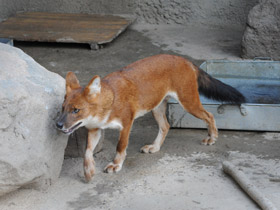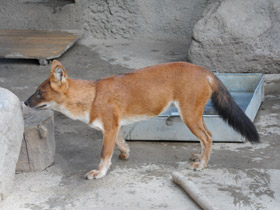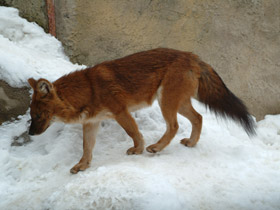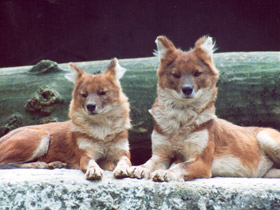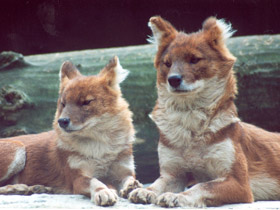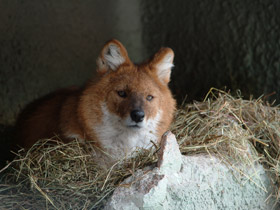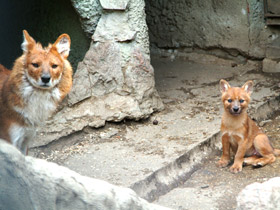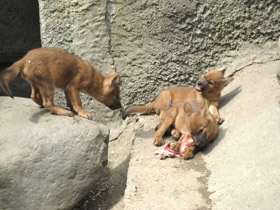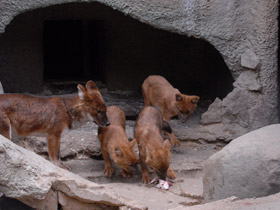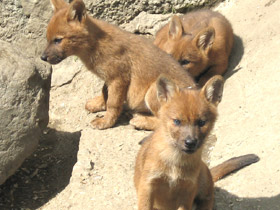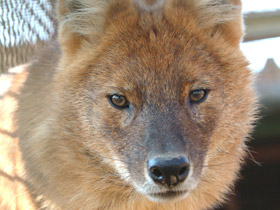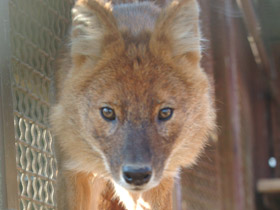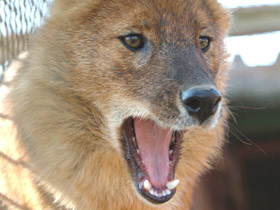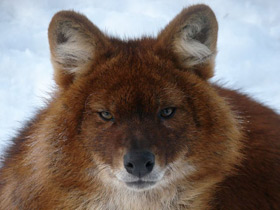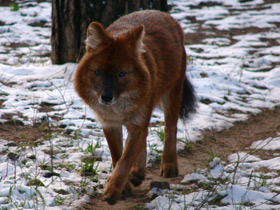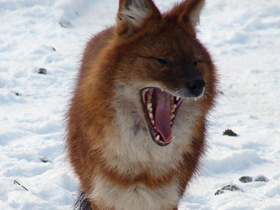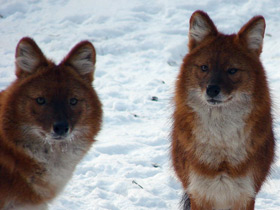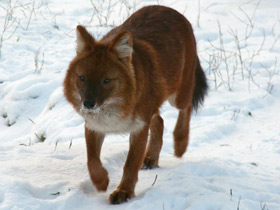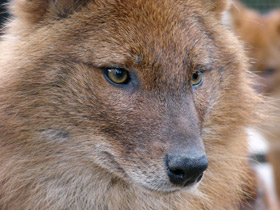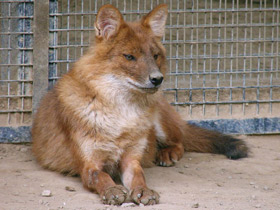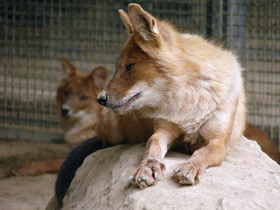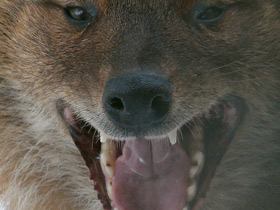The dhole, Asian wild dog, Asiatic wild dog, Indian wild dog, whistling dog, red dog, red wolf, and mountain wolf (Cuon alpinus)
The dhole (/doʊl/ dohl; Cuon alpinus) is a canid native to Central, South, East and Southeast Asia. It is genetically close to species within the genus Canis, but distinct in several anatomical aspects: its skull is convex rather than concave in profile, it lacks a third lower molar and the upper molars possess only a single cusp as opposed to between two and four. During the Pleistocene, the dhole ranged throughout Asia, Europe and North America but became restricted to its historical range 12,000–18,000 years ago.
The dhole is a highly social animal, living in large clans without rigid dominance hierarchies and containing multiple breeding females. Such clans usually consist of about 12 individuals, but groups of over 40 are known. It is a diurnal pack hunter which preferentially targets large and medium-sized ungulates. In tropical forests, the dhole competes with the tiger (Panthera tigris) and the leopard (Panthera pardus), targeting somewhat different prey species, but still with substantial dietary overlap.
It is listed as Endangered on the IUCN Red List, as populations are decreasing and estimated to comprise fewer than 2,500 mature individuals. Factors contributing to this decline include habitat loss, loss of prey, competition with other species, persecution due to livestock predation, and disease transfer from domestic dogs.
Etymology and naming
The etymology of "dhole" is unclear. The possible earliest written use of the word in English occurred in 1808 by soldier Thomas Williamson, who encountered the animal in Ramghur district, India. He stated that dhole was a common local name for the species. In 1827, Charles Hamilton Smith claimed that it was derived from a language spoken in 'various parts of the East'.
Two years later, Smith connected this word with Turkish: deli 'mad, crazy', and erroneously compared the Turkish word with Old Saxon: dol and Dutch: dol (cfr. also English: dull; German: toll), which are in fact from the Proto-Germanic *dwalaz 'foolish, stupid'. Richard Lydekker wrote nearly 80 years later that the word was not used by the natives living within the species' range. The Merriam-Webster Dictionary theorises that it may have come from the Kannada: ತೋಳ, romanized: tōḷa, lit. 'wolf'.
Other English names for the species include Asian wild dog, Asiatic wild dog, Indian wild dog, whistling dog, red dog, red wolf, and mountain wolf.
Taxonomy and evolution
Canis alpinus was the binomial name proposed by Peter Simon Pallas in 1811, who described its range as encompassing the upper levels of Udskoi Ostrog in Amurland, towards the eastern side and in the region of the upper Lena River, around the Yenisei River and occasionally crossing into China. This northern Russian range reported by Pallas during the 18th and 19th centuries is "considerably north" of where this species occurs today.
Canis primaevus was a name proposed by Brian Houghton Hodgson in 1833 who thought that the dhole was a primitive Canis form and the progenitor of the domestic dog. Hodgson later took note of the dhole's physical distinctiveness from the genus Canis and proposed the genus Cuon.
The first study on the origins of the species was conducted by paleontologist Erich Thenius, who concluded in 1955 that the dhole was a post-Pleistocene descendant of a golden jackal-like ancestor. The paleontologist Bjorn Kurten wrote in his 1968 book Pleistocene Mammals of Europe that the primitive dhole Canis majori Del Campana 1913 —the remains of which have been found in Villafranchian era Valdarno, Italy and in China—was almost indistinguishable from the genus Canis. In comparison, the modern species has greatly reduced molars and the cusps have developed into sharply trenchant points. During the Early Middle Pleistocene there arose both Canis majori stehlini that was the size of a large wolf, and the early dhole Canis alpinus Pallas 1811 which first appeared at Hundsheim and Mosbach in Germany. In the Late Pleistocene era the European dhole (C. a. europaeus) was modern-looking and the transformation of the lower molar into a single cusped, slicing tooth had been completed; however, its size was comparable with that of a wolf. This subspecies became extinct in Europe at the end of the late Würm period, but the species as a whole still inhabits a large area of Asia. The European dhole may have survived up until the early Holocene in the Iberian Peninsula. and what is believed to be dhole remains have been found at Riparo Fredian in northern Italy dated 10,800 years old.
The vast Pleistocene range of this species also included numerous islands in Asia that this species no longer inhabits, such as Sri Lanka, Borneo and possibly Palawan in the Philippines. Middle Pleistocene dhole fossils have also been found in the Matsukae Cave in northern Kyushu Island in western Japan and in the Lower Kuzuu fauna in Tochigi Prefecture in Honshu Island, east Japan. Dhole fossils from the Late Pleistocene dated to about 10,700 years before present are known from the Luobi Cave or Luobi-Dong cave in Hainan Island in south China where they no longer exist. Additionally, fossils of canidae possibly belonging to dhole have been excavated from Dajia River in Taichung County, Taiwan.
The fossil record indicates that the species also occurred in North America, with remains being found in Beringia and Mexico.
Appearance
Cuon alpinus is a species of carnivorous mammal of the family Canidae.
Cuon alpinus looks a little like a grey wolf and a little like a fox. It is smaller than a wolf, but larger than a fox: it is just over a metre long and weighs no more than 20 kilos. It has long, dense red fur, and its colouring resembles that of a fox. Its head, with a narrow fox-like muzzle and large triangular ears, is combined with a short torso and a fluffy, half-metre long wolf tail, similar to that of a fox, but thicker (photo 1, 2, 3, 4, 5). The strength and boldness of the wolf, the cunning of the fox, the greed and caution of the jackal were fused in the character of this beast, producing a most unusual fusion. With a reputation as bloodthirsty and dangerous killers, the enigmatic Cuon alpinus is also hardy, good hearing, swims well and, despite its short legs, can jump very well, covering a distance of up to 6 metres.
Social behaviour and breeding
Cuon alpinus lives and hunts in flocks of 5 to 12 animals (very rarely more than 20). A flock is an extended family consisting of one male, one female and several generations of cubs. Cuon alpinus are monogamous and remain faithful to their chosen mate for many years. Relationships within the pack are usually friendly and non-aggressive, and pups are often fed by several wolves in addition to their parents. On average there are 8 pups in a cub (sometimes as many as 16). Their teeth erupt on the 14th day, and at 3-4 weeks of age they begin to eat meat burped by adults. The cubs leave the den at 70-80 days, after which the pack continues to care for them, feeding them, accompanying them during play and allowing them to be the first to eat their ration. The cubs develop rapidly and at 5 months of age they actively follow the herd and almost reach the weight of adult animals, and at 8 months of age they begin to participate in the hunt.
Hunting and feeding
Cuon alpinus hunts mainly during the day, using various methods of hunting and attacking prey, depending on flock size, terrain and prey type. Their diet is quite varied, ranging from rodents, lizards and hares to deer and antelope; carrion is also not disdained. Rodents and hares are hunted by wolves alone, but large animals can only be hunted in packs. A pack of 15-20 wolves will successfully hunt buffalo or gaur, and protecting their hunting grounds, they will even take on a leopard and a tiger (how can we not remember the red or red-coloured dogs in Kipling's "Mowgli", of which Sherkhan himself was afraid)!
The Cuon alpinus seeks and finds its prey by scent, then the chase begins. They run slower than jackals and foxes, but they are extremely hardy and chase their prey to exhaustion. Wolves are very orderly, spread out in a chain and form an arc. Slowly flanking their prey, they try to drive it into open ground in summer and onto river or lake ice in winter, where deer, roe deer or wild boar are defenceless. Surprisingly, these predators regularly eat berries and other plant foods in summer. Adult wolves have been known to bring not only pieces of meat to their dens, but also rhubarb, a plant rich in vitamins, to their pups.
Denning
Four kinds of den have been described; simple earth dens with one entrance (usually remodeled striped hyena or porcupine dens); complex cavernous earth dens with more than one entrance; simple cavernous dens excavated under or between rocks; and complex cavernous dens with several other dens in the vicinity, some of which are interconnected. Dens are typically located under dense scrub or on the banks of dry rivers or creeks. The entrance to a dhole den can be almost vertical, with a sharp turn three to four feet down. The tunnel opens into an antechamber, from which extends more than one passage. Some dens may have up to six entrances leading up to thirty metres (100 ft) of interconnecting tunnels. These "cities" may be developed over many generations of dholes, and are shared by the clan females when raising young together. Like African wild dogs and dingoes, dholes will avoid killing prey close to their dens.
Hunting behaviour
Before embarking on a hunt, clans go through elaborate prehunt social rituals involving nuzzling, body rubbing and mounting. Dholes are primarily diurnal hunters, hunting in the early hours of the morning. They rarely hunt nocturnally, except on moonlit nights, indicating they greatly rely on sight when hunting. Although not as fast as jackals and foxes, they can chase their prey for many hours. During a pursuit, one or more dholes may take over chasing their prey, while the rest of the pack keeps up at a steadier pace behind, taking over once the other group tires. Most chases are short, lasting only 500 m (1,600 ft). When chasing fleet-footed prey, they run at a pace of 50 km/h (30 mph). Dholes frequently drive their prey into water bodies, where the targeted animal's movements are hindered.
Once large prey is caught, one dhole will grab the prey's nose, while the rest of the pack pulls the animal down by the flanks and hindquarters. They do not use a killing bite to the throat. They occasionally blind their prey by attacking the eyes. Serows are among the only ungulate species capable of effectively defending themselves against dhole attacks, due to their thick, protective coats and short, sharp horns capable of easily impaling dholes. They will tear open their prey's flanks and disembowel it, eating the heart, liver, lungs and some sections of the intestines. The stomach and rumen are usually left untouched. Prey weighing less than 50 kg (110 lb) is usually killed within two minutes, while large stags may take 15 minutes to die. Once prey is secured, dholes will tear off pieces of the carcass and eat in seclusion. Unlike wolf packs, in which the breeding pair monopolises food, dholes give access to the pups at a kill. They are generally tolerant of scavengers at their kills. Both mother and young are provided with regurgitated food by other pack members.
Feeding ecology
Prey animals in India include chital, sambar deer, muntjac, mouse deer, barasingha, wild boar, gaur, water buffaloes, banteng, cattle, nilgai, goats, Indian hares, Himalayan field rats and langurs. There is one record of a pack bringing down an Indian elephant calf in Assam, despite desperate defense of the mother, resulting in numerous losses to the pack. In Kashmir, they prey on markhor, and thamin in Myanmar, Malayan tapir, Sumatran serow in Sumatra and the Malay Peninsula and Javan rusa in Java. In the Tian Shan and Tarbagatai Mountains, dholes prey on Siberian ibexes, arkhar, roe deer, Caspian red deer and wild boar. In the Altai and Sayan Mountains, they prey on musk deer and reindeer. In eastern Siberia, they prey on roe deer, Manchurian wapiti, wild pig, musk deer and reindeer, while in Primorye they feed on sika deer and goral. In Mongolia, they prey on argali and rarely Siberian ibex.
Threats
Habitat loss is thought to amount to 60% of the dhole's historical range in India. The fragmentation and isolation of dhole populations has resulted in inbreeding and the Allee effect, which threaten its long term viability.
Some ethnic groups like the Kuruba and Mon Khmer-speaking tribes will appropriate dhole kills; some Indian villagers welcome the dhole because of this appropriation of dhole kills. Dholes were persecuted throughout India for bounties until they were given protection by the Wildlife Protection Act of 1972. Methods used for dhole hunting included poisoning, snaring, shooting and clubbing at den sites. Native Indian people killed dholes primarily to protect livestock, while British sporthunters during the British Raj did so under the conviction that dholes were responsible for drops in game populations. Persecution of dholes still occurs with varying degrees of intensity according to the region. Bounties paid for dholes used to be 25 rupees, though this was reduced to 20 in 1926 after the number of presented dhole carcasses became too numerous to maintain the established reward. The Indochinese dhole population suffers heavily from nonselective hunting techniques such as snaring. The fur trade does not pose a significant threat to the dhole. The people of India do not eat dhole flesh and their fur is not considered overly valuable. Due to their rarity, dholes were never harvested for their skins in large numbers in the Soviet Union and were sometimes accepted as dog or wolf pelts (being labeled as "half wolf" for the latter). The winter fur was prized by the Chinese, who bought dhole pelts in Ussuriysk during the late 1860s for a few silver rubles. In the early 20th century, dhole pelts reached eight rubles in Manchuria. In Semirechye, fur coats made from dhole skin were considered the warmest, but were very costly.
Subspecies
Cuon alpinus alpinus or eastern cuon - the largest of the subspecies. Thick fawn-red coat, greyish neck and ochre muzzle. It lives in southeast China, India, Nepal, Bhutan, Bangladesh, Burma, Thailand, Laos, Cambodia and Vietnam.
Cuon alpinus hesperius or western cuon - small subspecies now found only in western China. Long yellow-tinged fur, white underparts and pale whiskers Smaller than C. a. alpinus, with broader skull and lighter-coloured winter coat.
Cuon alpinus sumatrensis or Sumatran cuon is a small subspecies living on the islands of Sumatra and Java. Red fur and dark whiskers.
Cuon alpinus priscus † - lived during the first half of the Pleistocene.
Cuon alpinus fossilis † - inhabited Europe during the second half of the Pleistocene. It was an intermediate form between Cuon alpinus priscus and Cuon alpinus europaeus.
Cuon alpinus europaeus † - lived throughout Europe during the late Pleistocene. They were the last cuon to inhabit the European continent.
Cuon alpinus adjustus - Reddish fur, short hair on legs and black whiskers. Northeast India and south of the Ganges River, northern Myanmar.
Cuon alpinus dukhunensis - India south of the river Ganges, Pakistan, Afghanistan, central Asia.
Cuon alpinus fumosus - Lush yellowish red coat, dark back and grey neck. Western Sichuan, China and Mongolia. Southern Myanmar, Thailand, Laos, Cambodia, Vietnam, Malaysia and Java, Indonesia.
Cuon alpinus infuscus - southern Myanmar, Malaysia, Thailand and Vietnam.
Cuon alpinus javanocus - Java.
Cuon alpinus laniger - Full coat, yellowish grey, tail not black but of the same colour as the body. Southern Tibet, Nepalese Himalayas, Sikkim, Bhutan and Kashmir.
Cuon alpinus lepturus - Uniform red coat with thick undercoat. South of the Yangtze River, China.
Cuon alpinus primaevus - Himalayan areas of Nepal, Pakistan, Afghanistan, Tajikistan, Sikkim (India) and Bhutan.
Conservation status
Unfortunately, this canine species is rare everywhere. Cuon alpinus is included in the IUCN Red List and the Russian Red Data Book with the status of endangered species.

















